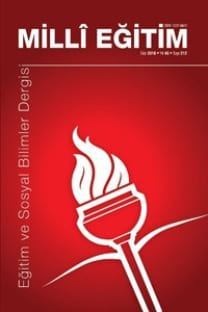EDEBİYAT EĞİTİMİ, ESTETİK BİR HAZZIN EDİNİMİ, OKUMANIN ALIŞKANLIĞA DÖNÜŞTÜRÜLMESİ VE YAZINSAL KURAMLAR
Bir dilin, dil bilgisinin ediniminde çoğu zaman yazınsal metinlere başvurulur,
yazınsal metinlerden yararlanılır. Ne var ki yazınsal metinler salt dil/dil bilgisi
öğretiminin aracı değildir. Yazınsal iletişimde, yazınsal metnin iletisi yine kendine
dönüktür. Yazınsal metin/yazınsal kuramlar ile dil ve edebiyat eğitimi arasında da
çok sıkı bir bağ vardır. Bir dilin öğretiminde çeşitli öğretim yöntemlerinden; edebiyat
eğitiminde de yazınsal, dil bilimsel, gösterge bilimsel kuramlardan yararlanılabilir,
yararlanılmalıdır. Dil öğretimi ve dil bilgisi, edebiyat eğitiminin alt basamağıdır.
Yazınsal kuramların bilinmemesi edebiyat eğitimini bir dil öğretimine, sözcük
çözümlemesine dönüştürmektedir. Edebiyat eğitimi, dil eğitiminden, okuma-yazma
eğitiminden farklı bir düzlemde yer alır, farklı amaçları hedefler.
Eğitim sistemimiz içinde edebiyat eğitiminin bir dil eğitimini, sözcük
çözümlemeyi aştığını gönül rahatlığı ile söyleyemeyiz. Liselerimizde,
üniversitelerimizde “Edebiyat Bilgi ve Teorileri”nin daha çok “bilgi” bölümü üzerinde
durulur ve bazı kurallar, dönemler, edebî sanatlar ezberletilir. Sonuçta, edebiyat
tarihsel bilgilerin, tanımların ezberlendiği bir “tarih” dersine, “edebiyat tarihi” dersine
dönüşür. Edebiyat tarihi dersi ise, aslında yazınsal metnin daha iyi anlaşılması için
vardır. Asıl amaç, yazınsal metnin sağlıklı bir şekilde anlamlandırılmasıdır.
Bu yazıda yazınsal metnin niteliği, yazınsal metne yaklaşım biçimleri, edebiyat
eğitimi/öğretiminin amaçları bağlamında yazınsal kuramlardan yararlanılması
gerektiği üzerinde durulacaktır.
LITERATURE TEACHING, ACQUISITION OF AN AESTHETİC TASTE, TRANSFORMING READING INTOHABIT AND LITERARY THEORIES
It has almost been an axiom to benefit from literary texts in the acquisition of
both a language and in deriving a pleasure from the use of that language. However,
literary texts cannot be regarded as mere instruments to learning a language or
practicing its grammar. In communication through literature, the message of a
literary text has an introvert character. Between literary texts/literature theories and
language/literature training, there is a constant relation. Different language teaching
methods are supposed to help language learning while theories related to literary,
linguistics and semiotics should ease literature training. It is assumed that language or grammar teaching or is the first step to literature training. Staying unaware of the
basic literature theories renders the literature training to mere language learning aid
or to vocabulary enhancement. Literature training takes place on a different level
from literacy or language teaching.
We cannot comfortably claim that literature training goes beyond the study on
words in texts. In current approach to this aim is to give much of the emphasis on
the ‘knowledge’ part of the Literary texts and theories’ courses and the second part
of the course title is often neglected. The content of the classes is limited to literary
rules, periods and styles. In the end, Literature training in practice turns into the
‘history of literature’ in which some historical background are presented and some
definitions are memorized. However, this course exists in order to prove its
contribution to understanding to the text. The goal is to render it a healthy sense of
understanding.
In this article, it is aimed to describe basic qualities of the text, and approaches
to analyze it and within the context of formal literature training, will be emphasized
applying literature theories while presenting literature training at schools.
